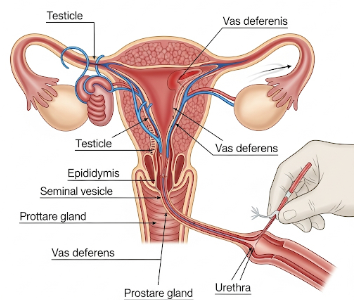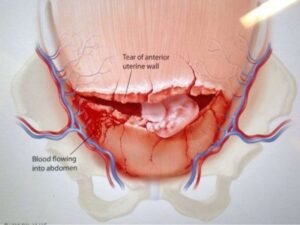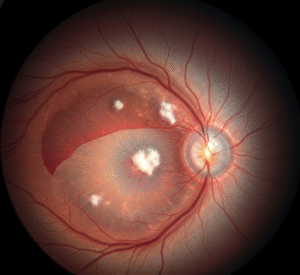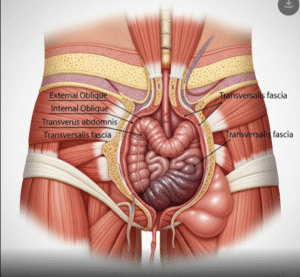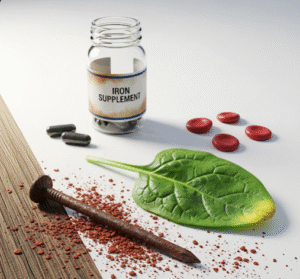Overview
A vasectomy is a surgical procedure for permanent male contraception that involves cutting, sealing, or blocking the vas deferens, the tubes that carry sperm from the testicles to the urethra. A bilateral vasectomy addresses both sides to ensure complete sterility.
South Korea is known for its high-quality urological care, offering minimally invasive techniques, expert surgeons, and comprehensive post-procedure guidance. Patients benefit from high success rates, minimal recovery time, and a safe, outpatient procedure.
Vasectomy is typically recommended for men who:
- ➤ Have completed their family planning
- ➤ Seek long-term, reliable contraception
- ➤ Prefer a minimally invasive procedure with low complication rates
- ➤ Want reversible options (vasectomy reversal) only if necessary, though not guaranteed)
What is a Vasectomy (Bilateral)?
A bilateral vasectomy involves cutting or sealing both vas deferens to prevent sperm from entering the ejaculate. It is considered one of the most effective forms of permanent contraception.
Key points:
- Typically performed under local anesthesia
- Outpatient procedure: usually completed within 20–30 minutes
- Can be conventional (incision) or no-scalpel vasectomy (NSV)
- Reversible surgery (vasectomy reversal) is possible but not guaranteed
- Minimal impact on sexual function, testosterone levels, or ejaculation volume
Korean hospitals and clinics offer advanced no-scalpel techniques, sterile operating environments, and expert follow-up, ensuring patient comfort and safety.
What are the Benefits?
✔ Highly effective permanent contraception (>99% effective)
✔ Minimally invasive with rapid recovery
✔ Preserves sexual function and hormone levels
✔ Outpatient procedure with minimal downtime
✔ Low risk of complications
Additional benefits include:
- ➤ Convenience compared to long-term contraception methods
- ➤ Cost-effective over a lifetime
- ➤ No ongoing medication or device required
- ➤ Korean hospitals provide precise techniques, pain management, and structured post-procedure care
Procedure Details:
1) How should I prepare for a Vasectomy?
- ● Preoperative consultation: Discuss medical history, medications, and expectations
- ● Physical examination: Assess scrotal anatomy and check for infections or abnormalities
- ● Medication adjustments: Avoid blood thinners if advised
- ● Hygiene: Shower and clean genital area thoroughly on the day of surgery
- ● Comfort: Wear snug underwear and loose clothing
- ● Korean hospitals: Provide pre-procedure counseling, clear instructions, and multilingual support
2) What happens during the procedure Vasectomy?
- ➤ Anesthesia: Local anesthesia numbs the scrotal area; sedation may be offered in some clinics
- ➤ Procedure steps:
- Conventional method: Small incisions on each side of the scrotum
- No-scalpel vasectomy (NSV): Tiny puncture to access vas deferens
- Vas deferens is cut, sealed, or blocked using surgical clips, sutures, or cauterization
- Small incision or puncture site closed with absorbable sutures or left to heal naturally
- ➤ Duration: 20–30 minutes
- ➤ Korean advantage: Skilled urologists ensure precision, minimal tissue trauma, and fast recovery
3) What happens after a Vasectomy?
- ● Immediate recovery: Ice packs applied to reduce swelling; mild pain or discomfort is expected
- ● Activity: Limit strenuous activity for 1 week; avoid heavy lifting or vigorous exercise
- ● Sexual activity: Resume after 1–2 weeks, but use alternative contraception until sperm clearance confirmed
- ● Follow-up: Semen analysis 8–12 weeks post-procedure to confirm azoospermia (absence of sperm)
- ● Korean hospitals: Provide comprehensive follow-up, patient education, and guidance on potential complications
Risks / Benefits
✔ Benefits:
- ✦ Permanent contraception with >99% effectiveness
- ✦ Minimally invasive, outpatient procedure
- ✦ Preserves sexual function and hormones
- ✦ Low complication rate and fast recovery
⚠ Possible Risks (rare):
- ➔ Mild pain, swelling, or bruising
- ➔ Infection at the incision site
- ➔ Hematoma formation
- ➔ Sperm granuloma (small lump from sperm leakage)
- ➔ Rare chronic testicular pain
- ➔ Need for vasectomy reversal if fertility desired in future (not guaranteed)
Recovery and Outlook
- ➤ Immediate recovery: Mild pain, swelling, or bruising for a few days
- ➤ Activity: Resume light activity immediately; avoid strenuous exercise or sexual activity for 1–2 weeks
- ➤ Semen analysis: Required after 8–12 weeks or 15–20 ejaculations to confirm absence of sperm
- ➤ Long-term outlook: Permanent contraception; minimal impact on sexual performance or hormone levels
- ➤ Korean advantage: High precision surgical techniques, structured follow-up, and expert care ensure safe, effective, and comfortable recovery
When To Call the Doctor
Contact your doctor if you notice:
- ⚠ Severe or persistent pain beyond expected recovery
- ⚠ Signs of infection (redness, pus, fever)
- ⚠ Significant swelling or hematoma formation
- ⚠ Chronic testicular discomfort
- ⚠ Concerns about fertility testing results
Best Korea Option / Process
South Korea offers world-class vasectomy services due to:
- 🌟 Highly skilled urologists and surgical teams
- 🌟 Advanced no-scalpel vasectomy (NSV) techniques
- 🌟 Minimally invasive procedures with fast recovery
- 🌟 Comprehensive preoperative counseling and postoperative care
- 🌟 Multilingual support for international patients seeking safe, effective permanent contraception
Top Korean Hospitals for Vasectomy:
- ✅ Seoul National University Hospital (Urology Dept.)
- ✅ Asan Medical Center
- ✅ Samsung Medical Center
- ✅ Severance Hospital (Yonsei University)
- ✅ Bundang CHA Hospital
✅ Quick Highlights Recap
- ➤ Bilateral surgical procedure for permanent male contraception
- ➤ Minimally invasive, outpatient procedure with rapid recovery
- ➤ Highly effective, preserves sexual function and hormones
- ➤ Rare risks, mostly minor and manageable
- ➤ Korean hospitals provide advanced techniques, precision surgery, and structured follow-up

